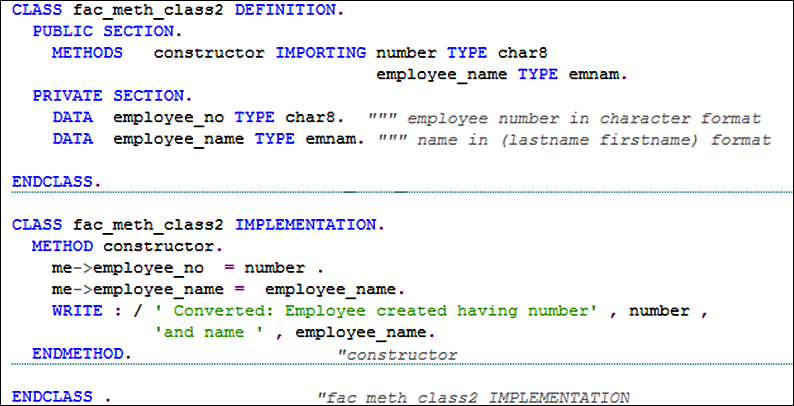Another important design pattern is the adapter design. As the name suggests, the adapter design is used for conversion of one object into another object belonging to a different class. An adapter class will have a method that takes as input the object reference that is to be converted and outputs it into the other object reference format.
We have referred to the cl_salv_tree_adapter standard class while making of this recipe.
In order to demonstrate the adapter, we need two classes (input class and output class). The input class will be the fac_meth_class created earlier. For the output, we will create another class fac_meth_class2. This will serve as the class, into the format of which the input object will be converted.

It is without a factory method for sake of simplicity. It contains employee number and employee name but the format of these two is different from the classes shown in the previous recipes. The employee name of this class is based on data element emnam, whereas the number is a character without zeros having length as eight. The name is of the form (firstname lastname), meaning John Reed will be stored as John Reed and not Reed John as in the previous recipes. The constructor outputs the message, Converted employee created.
We will use the same class used previously as the input object for the adapter method.
For creating a singleton class, follow these steps:
Create a deferred definition of the
adapterclassadapter_meth_classthat we are going to create in the next step.Specify the
adapter_meth_classas a friend of ourfact_meth_classclass in the definition via theFRIENDSaddition.
The
adapterclass is then defined. It contains astatic adaptermethod adapter that imports an object based onfac_meth_classand returns one in thefac_meth_class2 format.
The implementation of the
adapterclass is then created. It contains the code of theadaptermethod. Theadaptermethod will convert the incoming number of the employee from numeric to character format. In addition, the name of the employee is converted to thefirstname lastnameformat. The new object based on the second classfac_meth_class2is then created and returned as an exporting parameter of the method.
While calling the
adaptermethod, you first create an object based on thefac_meth_classclass that is afactorymethod (for illustrative purpose), similar to the previous recipe for the object referenceEMP. This is then passed on to thestatic adaptermethod of theadapter_meth_class. Theadapterclass returns the converted object in the second format.
When the program calls the static method adapter of the class adapter_meth_class , the code in the adapter method is executed. The adapter method calls the necessary code for converting the number into the character format and any zeros are removed from the number. In addition, the SPLIT statement is called for converting name of the employee in the (first name last name) format such as converting Reed John into John Reed. Finally the CREATE OBJECT is called in order to create the object in the converted class format . This triggers the constructor for the converted class fac_meth_class2 that outputs the message "Converted: Employee Created having number 1234" and name John Reed. Since we called the factory method of the original fac_meth_class before the adapter method call, the original constructor was also called and message printed also.




